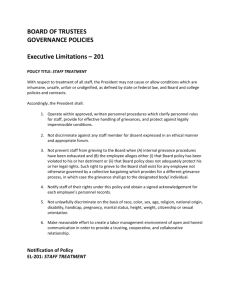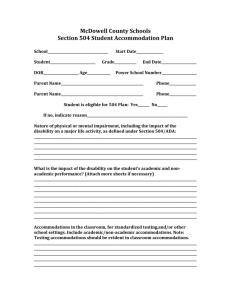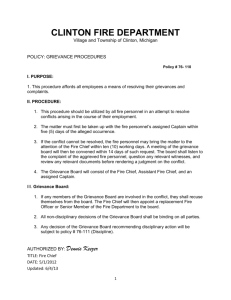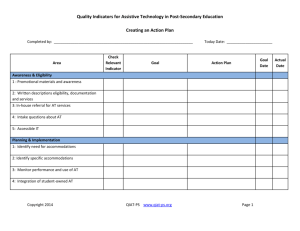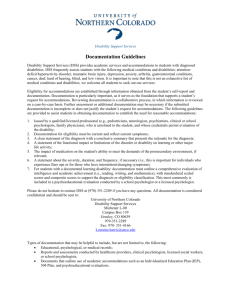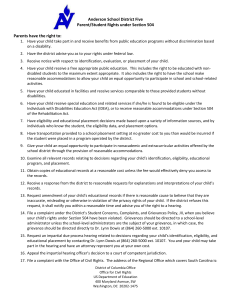504 Manual - Linn-Mar Community School District
advertisement
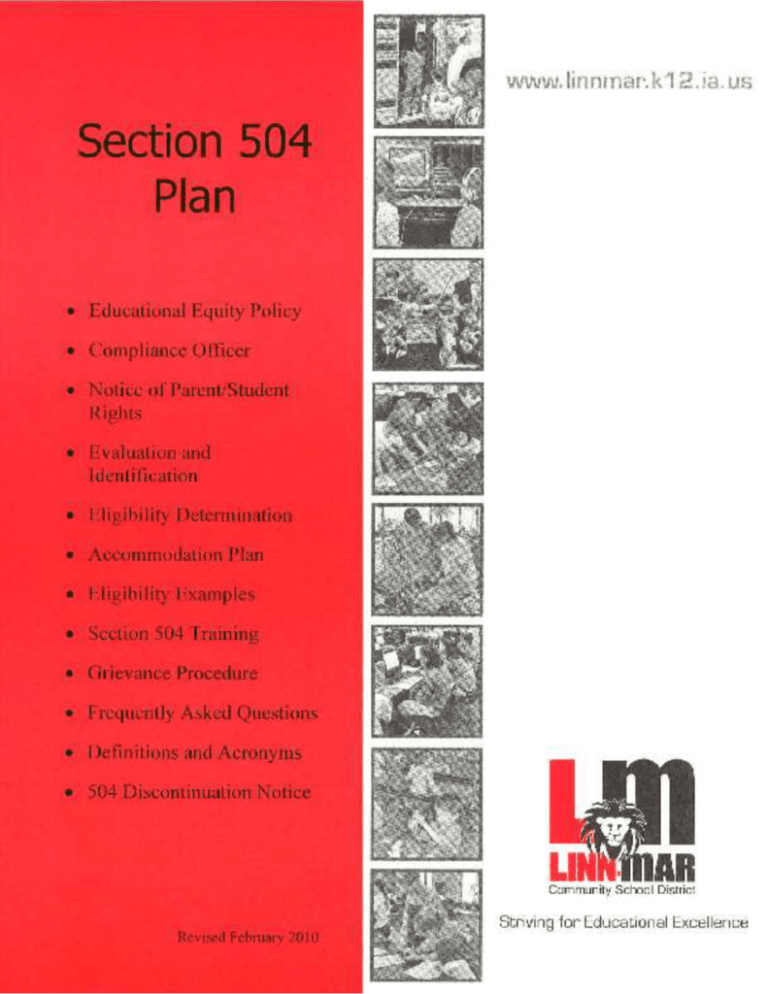
A Parent Guide to SECTION 504 of the Rehabilitation Act of 1973 Mission Statement: We are a learning community working together to develop our students by educating them to confidently meet life’s challenges. The person at Linn-Mar Community School District responsible for Section 504 is: Julie Jensen Executive Director of Student Services Linn-Mar Community School District 3333 N 10th Street Marion, Ia 52032 Email: jjensen@linnmar.k12.ia.us Phone: 319-447-3003 Fax: 319-377-9252 A Parent Guide to Section 504 is designed to give parents a short overview of Section 504 of the Rehabilitation Act of 1973 as it pertains to Linn-Mar Community Schools. While Section 504 defines the equal access requirements for both students and employees, this publication will focus on students. This information has been organized around questions parents frequently ask when trying to understand this civil rights statute. Please note that when working with disabled students, Section 504 serves the same purpose as the ADA (Americans with Disabilities Act). Consequently, this publication focuses solely on Section 504. What is Section 504? Section 504 of the Rehabilitation Act of 1973 is Congress’ directive to schools receiving any federal funding to eliminate discrimination based on disability from all aspects of school operation. Since the Linn-Mar Community School district receives federal dollars, it is required to provide eligible disabled students with equal access to services, programs, and activities offered by the District. Section 504 is a civil rights statute and not a special education statute. Therefore, it is the responsibility of regular education staff and building administration to implement those practices and procedures necessary for a school to fulfill the requirements of this law. It is also important to understand that schools receive no additional funding to implement Section 504 accommodations. At each school, the responsibility for ensuring Section 504 compliance rests with the building principal or principal’s designee. What criteria are used to determine if a student is eligible for a Section 504 plan? Like other students, those students with a disability, as defined by Section 504, are entitled to a free appropriate public education. An appropriate education for a Section 504 disabled student may require the provision of specific accommodations and related services in order to meet the needs of the student. Section 504 focuses on ensuring a level of access to educational services and the learning process for qualified disabled students that is equal to that given non-disabled students. Students eligible for Section 504 accommodation plans must meet three criteria. The three criteria are (1) A mental or physical impairment, (2) which substantially limits, (3) one or more major life activities. It is important to understand that all three criteria must be present for a student to be eligible for a Section 504 accommodation plan. Equally important, this disability must be why the student cannot equally access or receive benefit from the school’s programs and services. Here is additional information on each of the three criteria. Mental or physical impairment: This includes any physiological disorder or condition, cosmetic disfigurement, or anatomical loss affecting one or more body systems. Additionally, this can include any mental or psychological disorder. This criterion does not limit eligibility to specific diseases or categories of medical conditions. The law was intentionally written this way to avoid limiting the range of diseases or medical conditions that might be considered for Section 504 eligibility. January 25, 2010 Substantially limits: Section 504 does not specifically define the term “substantially limits.” The basis for evaluating this criterion is the impact a disability has on one or more of a student’s major life activities. It is vital to understand that for a student to qualify for Section 504, the impairment must impose a considerable limitation on one or more major life activities. The eligibility team will consider the nature and severity of the disability as well as how long the disability is expected to last. Simply having a condition or disability does not automatically qualify a student for Section 504 protection. The condition must present a barrier to the student’s ability to access the same education opportunities as a non-disabled student. Major life activities: Major life activities include such things as: seeing, hearing, eating, sleeping, walking, standing, lifting, bending, speaking, working, breathing, learning, reading, communicating, thinking, concentrating, caring for oneself, and performing manual tasks. The operation of major bodily functions (e.g., the functions of the immune system, normal cell growth, and digestive, bowel, bladder, respiratory, circulatory, endocrine, neurological, brain, and reproductive functioning) count as major life activities. Please not that this list of major life activities is not exhaustive. How is a Section 504 review request made? A parent guardian, teacher, building team, counselor, related service provider, other school staff, administrator, or community agency can initiate a referral for Section 504 eligibility to the building intervention team. This team looks different in each building, but usually involves administrators, counselors and GWAEA staff. It is a good idea to discuss the appropriateness of a 504 Plan with your child’s teacher, counselor, building 504 coordinator or principal before making the referral, as there are numerous intervention strategies used with students. By discussing your concerns with one of these people, it can be determined if pursuing a 504 Plan will best support the student’s needs. What process is used in determining if a student is eligible for a Section 504 plan? Upon receipt of a 504 referral, the school-level building intervention team will determine whether or not an evaluation will occur. If an evaluation will occur, the Coordinator will arrange a meeting (or have a phone call) with parents to review the referral and discuss the evaluation process. The Coordinator will also make arrangements for a 504 team meeting to review the referral and determine the evaluation data that should be collected, as well as set a date for an eligibility determination meeting. As mentioned above, a student is eligible for Section 504 protection when it is determined by the 504 team that he/she has a physical or mental impairment that substantially limits one or more of the major life activities, and the impairment is impacting access and student benefit from school programs and services. A properly convened eligibility team needs to include individuals who are knowledgeable about the needs of the student, the interpretation of the data being reviewed, and the accommodation/service options available. This team can include (but is not limited to) January 25, 2010 parents/guardians, teachers, counselors, related service providers, other school staff and administrators, and staff from community agencies. Parents/guardians should be included in this process whenever possible. The team’s first responsibility is to review the nature of the impairment and determine how it affects the student’s access to educational programs and activities. Section 504 eligibility meetings are not intended to be as comprehensive as a special education evaluation. However, in every case the eligibility team needs to investigate the specific concern that triggered the request. Information that might be considered includes (but is not limited to): grades, attendance reports, behavior plans, cumulative file information, psychological evaluations, medical information, observations, and standardized testing information. As needed, the eligibility team may administer and use other formal and informal measures that help them determine 504 eligibility. Parents will be asked for their consent to obtain these measures. How are 504 accommodations and related services documented and reviewed? If the eligibility team determines that a student has a Section 504 disability, the team’s second responsibility is to identify the specific accommodations or services that will support equal access. Documentation of these accommodations is done in a Section 504 Accommodation Plan. This plan provides a summary of the accommodations that a student requires to ensure equal access to the learning process and/or district programs, activities, and services. This document becomes part of the student’s cumulative file. 504 eligibility teams review active Section 504 Accommodation Plans yearly with more frequent meetings occurring if needed. The purpose of a yearly review is to add, subtract and/or modify student accommodations as needed. If a student no longer needs a 504 Plan, the eligibility team terminates it at a review session. What is meant by the word “accommodation”? Where will the accommodations occur? Section 504 requires that a student with an eligible disability be educated with students who do not have disabilities to the maximum extent appropriate. This is referred to as educating the student in the least restrictive environment. Implementation of most Section 504 Plans occurs in the regular classroom. Accommodations generally are those minor adjustments to things like seating arrangements, lesson presentation, assignments, and other facets of the learning environment that provide the student with equal access to learning opportunities. An example might be moving the student to a position in the room that best supports his/her ability to focus on schoolwork. Accommodations might involve the use of such things as special visual aids, large print, or using video recordings. Allowing a student additional time to complete a specific kind of task is also an accommodation. There are countless accommodations that can support a student’s equal access to educational opportunities. It is the job of the eligibility team to identify those accommodations that will support the needs of a given student resulting from the identified impairment. Please keep in mind that each school will include accommodations that it has the ability to accomplish based on what the school offers to all students and resources available to implement its programs and services. This means that the accommodations will be designed differently at different schools and at different levels (elementary, middle, high school). What rights do parents (and students) have under Section 504? The following is a list of parent rights granted by federal law. The intent of the law is to keep parents fully informed concerning decisions made about their children and to inform them of their rights should disagreement occur over a 504 decision. As a parent, you have the right to: Have your child take part in, and receive benefit from, public education programs without discrimination based on a disability. Have the district advise you as to your rights under the law. Receive notice with respect to the identification, evaluation, or placement of your child. Have your child receive a free appropriate public education. This includes the right to be educated with non-disabled students to the maximum extent appropriate. It also includes the right to have the district make reasonable accommodations to allow your child an equal opportunity to participate in school and school-related activities. Have your child educated in facilities and receive services comparable to those provided students without disabilities. Have your child receive special education and related services if she/he is found to be eligible under the Individuals with Disabilities Education Act (IDEA), or to receive reasonable accommodations under Section 504 of the Rehabilitation Act. Have eligibility and educational placement decisions made based upon a variety of information sources, and by individuals who know the student, the eligibility data, and placement options. Give your child an equal opportunity to participate in non-academic and extracurricular activities offered by the district through the provision of reasonable accommodations. Examine all relevant records relating to decisions regarding your child’s identification, eligibility, educational program, and placement. Obtain copies of educational records at a reasonable cost unless the fee would effectively deny you access to the records. Receive a response from the district to reasonable requests for explanations and interpretations of your child’s records. Request amendment of your child’s educational records if there is a reasonable cause to believe that they are inaccurate, misleading or otherwise in violation of the privacy rights of your child. File a complaint with the district when you believe your child’s rights have been violated. January 25, 2010 Request an impartial hearing related to decisions regarding your child’s identification, eligibility, and educational placement. You and your child may take part in the hearing and have an attorney present at your own cost. File a formal complaint with the Iowa Department of Education or the U.S. Department of Education Office for Civil Rights (Region VII): Whom should parents contact when they have a Section 504 complaint? The best solutions to parent and student concerns occur at the school level. Therefore, the first step in resolving a complaint involves the parent or guardian contacting the building principal and discussing the issue with the principal and other appropriate building staff. If the issue is not resolved through these discussions, the parent or guardian can file a Section 504 Complaint Form with the school principal. A sample Complaint form is included in this handout. The form is also available at your local school. If the issue is not resolved at the building level, the parent or guardian can continue the complaint process by forwarding a copy of the complaint to the district’s Section 504 Coordinator. The Section 504 Coordinator will work with the Section 504 Compliance Officer in reviewing and responding to the parent concern. If the concern is still not resolved, the Superintendent or designee will review the decision to determine if all district and 504 policies have been followed. As noted above, you also have the right to request an impartial hearing related to any decisions regarding your child’s identification, eligibility, and educational placement. Request for hearings shall be submitted to the District 504 Compliance Officer. Upon receiving a written request for a hearing, the District 504 Compliance Officer will contact a Resolution Facilitator from Grant Wood Area Education Agency who hears cases pursuant to the Individuals with Disabilities Education Act and who has been trained regarding Section 504. The hearing officer will schedule a due process hearing to occur as soon as reasonably possible for the parent/legal guardian and district. The parent/legal guardian and district may be represented by legal counsel at the hearing, may examine relevant records, and participate in the hearing. Within ten (10) days after the conclusion of the hearing, the hearing officer will render a written decision. The written decision shall include applicable findings of fact and conclusions of law. The hearing officer shall submit the written decision to the parent/legal guardian and to the Board of Education. The decision of the hearing officer shall constitute the final administrative decision on the Section 504 matter. Finally, note the Office for Civil Rights (OCR) is the federal agency responsible for enforcing Section 504 compliance. While we believe that the best resolutions occur at the school level, parents/guardians always have the right to initiate a complaint with the OCR. January 25, 2010 MODEL GRIEVANCE PROCEDURE A Model Grievance Procedure for Schools, Area Education Agencies, and Community Colleges A model to assist educational agencies process complaints of discrimination on the basis of gender, race, national origin, religion, sexual orientation, gender identity, disability, marital status, and age Iowa Department of Education Teaching and Learning Services 2008 State of Iowa Department of Education Grimes State Office Building Des Moines, Iowa 50319-0146 January 25, 2010 State Board of Education Rosie Hussey, Clear Lake, President Charles C. Edwards, Jr., Des Moines, Vice President Sister Jude Fitzpatrick, West Des Moines Brian Gentry, Des Moines Joan Jaimes, Marshalltown Valerie Kruse, Sioux City Wayne Kobberdahl, Council Bluffs Max Phillips, Woodward LaMetta Wynn, Clinton Kameron Dodge (Student Member), Cambridge Administration Judy A. Jeffrey, Director and Executive Officer of the State Board of Education Gail M. Sullivan, Chief of Staff Division of PK-12 Education Kevin Fangman, Administrator James Reese, Chief, Teaching and Learning Services Cynthia Knight, Consultant, Teaching and Learning Services It is the policy of the Iowa Department of Education not to discriminate on the basis of race, creed, color, sex, sexual orientation, gender identity, national origin, gender, disability, religion, age, political party affiliation, or actual or potential parental, family, or marital status in its programs, activities, or employment practices as required by the Iowa Code sections 216.9 and 256.10(2), Titles VI and VII of the Civil Rights Act of 1964 (42 U.S.C. § 2000d and 2000e), the Equal Pay Act of 1973 (29 U.S.C. § 206, et seq.), Title IX (Educational Amendments, 20 U.S.C. §§ 1681 – 1688), Section 504 (Rehabilitation Act of 1973, 29 U.S.C. § 794), and the Americans with Disabilities Act (42 U.S.C. § 12101, et seq.). If you have questions or grievances related to compliance with this policy by the Iowa Department of Education, please contact the legal counsel for the Iowa Department of Education, Grimes State Office Building, Des Moines, IA 50319-0146, telephone number 515/281-5295, or the Director of the Office for Civil Rights, U.S. Department of Education, 111 N. Canal Street, Suite 1053, Chicago, IL 60606-7204. 281-5295, or the Director of the Office for Civil Rights, U.S. Department of Education, 111 N. Canal Street, Suite 1053, Chicago, IL 60606-7204 . January 25, 2010 Grievance Procedures: Major Issues An internal grievance procedure is a convenient vehicle for dealing with small problems before they become big ones. Title IX of the Education Amendments of 1972 (Gender Equity), Section 504 of the Vocational Rehabilitation Act of 1973 (Disability Equity) and Chapter 19B.11 of the Iowa Code (Equal Employment Opportunity/Affirmative Action) all require educational agencies to have a procedure for processing complaints of discrimination. The grievance procedure must be available to students, employees, applicants for employment, and parents of students in elementary/secondary schools. The procedure should cover grievances claiming discrimination on the basis of gender, race, national origin, religion, age, marital status, sexual orientation, gender identity, and disability. Although grievance procedures may take varying forms, they should clearly specify the format and procedures for filing grievances. They should clearly specify any applicable time limits in the process. The grievance procedure should clearly identify the institutional/agency staff that has responsibility for the receipt of grievance and the facilitation of the grievance process (usually the local educational equity/affirmative action coordinator). Specific forms for filing and documenting grievances should be available. Grievance procedures get used only when people know they exist. The laws require that information about the grievance procedure be disseminated to students, employees, parents of students, and applicants for employment on an annual or on-going basis. Information about the grievance procedure must be included in the major annual publications or formal communications targeted at these groups. The master employee contract grievance procedure may be used as the non-discrimination grievance procedure for employees, but only if two conditions are met. The first is that there is a non-discrimination clause in the master contract. The second condition is that employees be notified annually or in an on-going fashion in employee handbooks that the master employee contract grievance procedure will serve as the non-discrimination grievance procedure for employees. There may be a need to make modifications in this model to fit the context of a community college, area education agency, or school district. January 25, 2010 Model Grievance Procedures Students, parents of students, employees, and applicants for employment in the Linn-Mar Community School District shall have the right to file a formal complaint alleging discrimination under federal or state regulations requiring non-discrimination in programs and employment. Level One – Principal, Immediate Supervisor or Personnel Contact person (Informal and Optional – may be by passed by the grievant) Employees with a complaint of discrimination based upon their gender, race, national origin, religion, age, marital status, sexual orientation, gender identity, or disability are encouraged to first discuss it with their principal, dean, or immediate supervisor, with the objective of resolving the matter informally. A student, a parent of a student, or an applicant for employment with a complaint of discrimination based upon their gender, race, national origin, religion, age, marital status, sexual orientation, gender identity, or disability are encouraged to discuss it with the instructor, counselor, supervisor, building administrator, program administrator, or personnel contact person directly involved. Level Two – The Equity Coordinator If the grievance is not resolved at level one and the grievant wishes to pursue the grievance, they may formalize it by filing a complaint in writing on a Grievance Filing form, which may be obtained from the Educational Equity Coordinator. The complaint shall state the nature of the grievance and the remedy requested. The filing of the formal, written complaint at level two must be within fifteen (15) working days from the date of the event giving rise to the grievance, or from the date the grievant could reasonably become aware of such occurrence. The grievant may request that a meeting concerning the complaint be held with the Educational Equity Coordinator. A minor student may be accompanied at that meeting by a parent or guardian. The Equity Coordinator shall investigate the complaint and attempt to resolve it. A written report from the Equity Coordinator regarding action taken will be sent to the involved parties within fifteen (15) working days after receipt of the complaint. Level Three – The Grievance Committee If the grievance is not resolved at level two, the grievant may appeal it at level three by presenting a written appeal to the Grievance Committee within ten (10) working days after the grievant receives the report from the Equity Coordinator. The Grievance Committee shall include five persons, including one administrator, one instructor/teacher/consultant, one classified/non-certificated employee, one student, and one parent/community representative. At least two members of the Grievance Committee shall be selected from the current Educational Equity Advisory Committee (Multicultural, Non-sexist Education/Affirmative Action Advisory Committee(s)). The Grievance Committee shall include both men and women and reflect racial/ethnic diversity and persons with disabilities when possible. The grievant may request a meeting with the Grievance Committee to discuss the appeal and the Grievance Committee may request a meeting with the grievant. A decision will be rendered by the Grievance Committee within ten (10) working days after receipt of the written appeal. January 25, 2010 Level Four – Superintendent/Administrator If the complaint is not resolved at level three, the grievant may appeal it to level four by presenting a written appeal to the Superintendent/Administrator within ten (10) working days after the grievant receives the report from the Grievance Committee. The grievant may request a meeting with the Superintendent/Administrator or his/her designee. The Superintendent/Administrator may request a meeting with the grievant to discuss the appeal. A decision will be rendered by the Superintendent/Administrator or his/her designee within ten (10) working days after the receipt of the written appeal. This procedure in no way denies the right of the grievant to file formal complaints with the Iowa Civil Rights Commission, the Federal Office of Civil Rights, Equal Employment Opportunity Commission, the Iowa Department of Education for mediation or rectification of civil rights grievances, or to seek private counsel for complaints alleging discrimination. The Education Equity Coordinator is: Dirk Halupnik Executive Director of Instructional Services Linn-Mar Community School District 3333 N 10th Street, Marion, IA 52302 Phone: 319-447-3028 Fax: 319-377-9252 Email: dhalupnik@linnmar.k12.ia.us January 25, 2010 Grievance Form for Complaints of Discrimination or Non-Compliance with Federal or State Regulations Requiring Non-Discrimination I, , am filing this grievance because (Attach additional sheets if necessary) Describe incident or occurrence as accurately as possible: (Attach additional sheets if necessary) January 25, 2010 Grievance Documentation Name of Individual Alleging Discrimination or Non-Compliance Name: Grievance Date: State the nature of the complaint and the remedy requested: Indicate principal’s or supervisor’s response or action to above complaint: Signature of Principal or Supervisor January 25, 2010 NOTICE TO PARENT OF 504 EVALUATION Your child has been referred to the building intervention team at School because of a concern that he/she has a physical or mental disability that substantially limits a major life activity – possibly making him/her eligible for protection under Section 504. Like other students, those students with disability, as defined by Section 504, are entitled to a free appropriate public education. An appropriate education for a Section 504 disabled student may require the provision of specific accommodations and related services in order to meet the needs of the student. Section 504 focuses on ensuring a level of access to education services and the learning process for qualified disabled students that is equal to that given non-disabled students. Students eligible for Section 504 accommodation plans must meet three criteria. The three criteria are (1) A mental or physical impairment, (2) which substantially limits, (3) one or more major life activities. It is important to understand that all three criteria must be present for a student to be eligible for a Section 504 accommodation plan. Equally important, this disability must be why the student cannot equally access or receive benefit from the school’s programs and services. In order for your son/daughter to be eligible for 504 services, a team of school personnel must conduct an evaluation. This will involve acquiring information from a variety of sources. Sources of information may include, but are not limited to: your child’s student file, discipline reports, teacher information, observation data, parent information, and information from medical and/or mental health professionals. PARENT PERMISSION FOR EVALUATION The school asks your permission to conduct an evaluation in order to determine eligibility for Section 504 accommodations. I hereby GRANT / DENY (circle one) permission for the Linn-Mar Community School District to conduct a Section 504 evaluation on my child. I have received a copy of the Parent’s Notice of Section 504 Rights. / Signature of Parent/Guardian Copies: Parent, Section 504 Folder, Section 504 Coordinator Date / SECTION 504/ADA STUDENT ELIGIBILITY FORM* Student: DOB: School: Grade: Evaluation Information: (Check all that apply) Psychological Evaluation Physician Report Achievement Tests Teacher Recommendations Observation Data 1. / / Teacher Recommendations Discipline History Parent Information Curriculum Based Assessments Other (specify): Does the student have a mental or physical impairment (as recognized in DSM-IV or other respected source if not excluded under 504/ADA, e.g., illegal drug use)? No (if no, go to eligibility determination section) Yes (if yes, identify the impairment and supporting data) Impairment: Supporting Data: 2. Describe how the impairment limits a Major Life Activity (MLA) or Major Bodily Function (MBF) 3. Place an “X” on the following scale to indicate the specific degree that the impairment (in #1) limits the major life activity (in #2): Make an educated estimate without the effects of mitigating measures, such as medication; low-vision devices (except eyeglasses or contact lenses); hearing aids and cochlear implants, mobility devices, prosthetics, assistive technology; learned behavioral or adaptive neurological modifications; and reasonable accommodations or auxiliary aids/services. Similarly, for impairments that are episodic or in remission, make the determination for the time they are active. Use the average student in the general population as the frame of reference. Interpret close calls in favor of broad coverage (i.e., construing Items 1-3 to maximum extent that they permit). Thus, for an “X” at 4.0 or below, fill in specific information evaluated by the team that justifies the rating: 5. 4. 3. 2. 1. 4. Extremely Substantially Moderately Mildly Negligibly If the team’s determination for #3 was less than “4”, provide notice to the parents of their procedural rights, including an impartial hearing. If the team’s determination was a “4” or above, the team should determine and list on the 504/ADA Plan the specific accommodations that are necessary for the child to have an opportunity commensurate with non-disabled students (of the same age). *Adapted with permission from Perry A Zirkel, author of Section 504, the ADA and the Schools. Copies: Parent, Teachers, Section 504 Folder, Section 504 Coordinator Eligibility Determination Based on the analysis of the evaluation data, does the student have a disability that substantially limits a major life activity? No, the student is not Section 504 eligible. Yes, the student is Section 504 eligible, but does not require a plan because (1) of the corrective effects of mitigating measures or (2) the impairment is episodic or in remission. The 504 team will be re-convened as necessary to review the status of the student’s disability. Yes, the student is 504 eligible and requires and accommodation plan. Team Signatures Date / / / / / / / Position / / / / / / / Parental Notice I have participated in the Section 504 Eligibility process and have received copies of this notice and the Parent’s Notice of Section 504 Rights. / Parent Signature *Adapted with permission from James McKethan, author of Implementing Section 504 as Amended by the ADAAA08 Copies: Parent, Teachers Section 504 Folder, Section 504 Coordinator Date / Linn-Mar Community School District SECTION 504 ACCOMMODATION PLAN Student: DOB: School: Grade: Conference Date: / / Review Date: / / / / This student has been found to be Section 504 eligible and requires the following accommodations based on evaluation information from a variety of sources that is documented on the Notice of Eligibility. Area of Concern: Accommodations: Modifications: / / Area of Concern: Accommodations: Modifications: / / Area of Concern: Accommodations: Modifications: / / Student name: School: Team Signatures Date / / / / / / / / / / / / / / Position Parent Notice I participated in the development of this 504 Plan and have received a copy of the Parent’s Notice of Section 504 Rights. / Parent Signature Copies: Parent, Teachers, Section 504 Folder, Section 504 Coordinator / Date SECTION 504 ANNUAL REVIEW Student name: Review Date: / School: / 1. No modifications needed – continue with plans as written. 2. Adjustments needed. See Accommodations page for modifications. 3. New plan to be written. 4. Plan discontinued because: a. Student is no longer substantially limited. b. Student meets IDEA eligibility requirements and will have an IEP. Team Agreement: / / / / / Initial/date Initial/date Initial/date Initial/date Initial/date Review Date: / / Parents Initial/date** / 1. No modifications needed – continue with plan as written. 2. Adjustments needed. See Accommodations page for modifications. 3. New plan to be written 4. Plan discontinued because: a. Student is no longer substantially limited. b. Student meets IDEA eligibility requirements and will have an IEP. Team Agreement: / Initial/date / / / Initial/date Initial/date Initial/date / Initial/date / Parents Initial/date** **I participated in the development of this plan and have received a copy of the Parent’s Notice of Section 504 Rights Copies: Parent, Teachers, Section 504 Folder, Section 504 Coordinator
